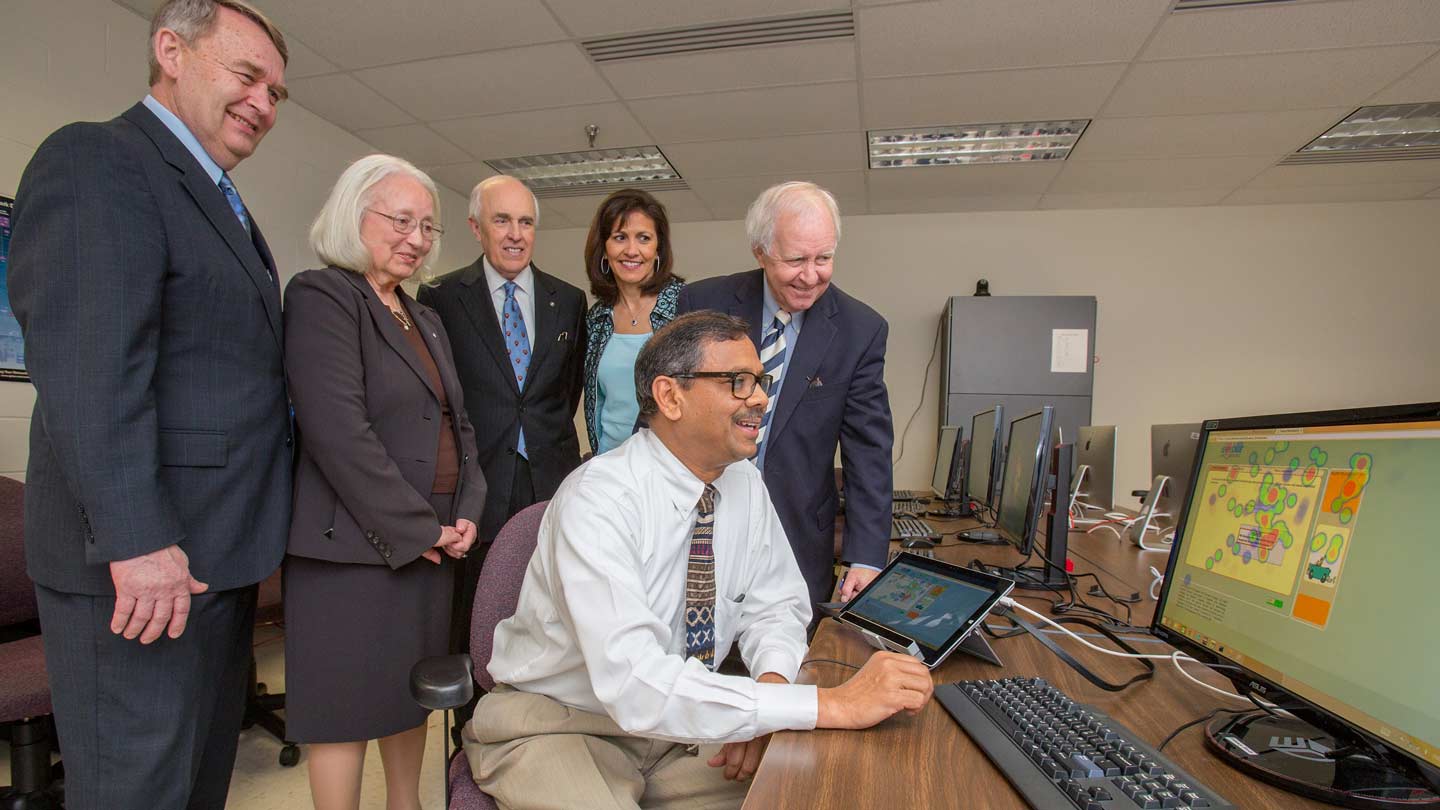
During its dedication, Dr. Heggere Ranganath, chair of the UAH Department of Computer Science, explains features of the lab to, from left, Marc Bendickson, president of Dynetics Inc. and UAH Foundation vice chair; Dorothy Davidson, Davidson Cybersecurity Lab donor and member of the UAH Foundation board; Dag Rowe, Huntsville attorney and UAH Foundation chair; and Irma Tuder, Analytical Services Inc. CEO and UAH Foundation Development Committee chair.
Michael Mercier | UAH
The neat rows of new computer displays and keyboards behind the door of Room N325 in Olin B. King Technology Hall belie their significance. This isn't simply another well-equipped classroom in the Computer Science Department at the University of Alabama in Huntsville (UAH). It's the Davidson Cybersecurity Laboratory, developing a new generation of high-tech warriors and shields - the people, techniques, software and hardware needed to safeguard vital information and systems from the growing threat of cyber attacks.
In 2014, members of the computer science faculty wrote to Dr. Ray Vaughn, vice president for research and economic development, proposing the establishment of a laboratory to augment UAH's interdisciplinary cybersecurity program, which involves the Colleges of Science, Engineering and Business Administration. Initial funding was secured and soon a room was being outfitted with special wiring and infrastructure, computers, servers, software and equipment.
Dr. Heggere Ranganath, chairman of the UAH Computer Science Department, says faculty and graduate students are working in the lab, which was fully established about five months ago. Undergraduate students began working and learning there with start of the fall 2015 semester. He expects more than 200 students at all levels will use it each year.
For students, it gives them an opportunity to experience cybersecurity techniques in a safe, laboratory setting. They will get hands-on experience and that’s very important. There is a huge demand for graduates, locally and nationally, and it’s only going to continue growing. Everybody is interested in protecting information and protecting themselves from cyber attacks.
"For students, it gives them an opportunity to experience cybersecurity techniques in a safe, laboratory setting. They will get hands-on experience and that's very important," Dr. Ranganath says. "There is a huge demand for graduates, locally and nationally, and it's only going to continue growing. Everybody is interested in protecting information and protecting themselves from cyber attacks."
The laboratory is already helping faculty members attract funded research projects, he says. Computer science and computer engineering faculty collaborated on work in the laboratory that was used in a proposal that won a National Security Agency grant of nearly $300,000 earlier this year.
Dorothy Davidson, chairman and chief executive officer of Davidson Technologies in Huntsville, recently toured the facility and made a major contribution to aid its future development. It was named the Davidson Cybersecurity Laboratory to recognize her investment in the program.
"Cyber is a mainstay in everything that we all do today in the country. UAH is investing in cyber research and solutions, as is Davidson Technologies," she says, adding that the company even has an intern from the UAH Computer Science Department doing cyber work. "I felt that this donation was an opportunity to support UAH and their work in this growing field."
The new laboratory is an ideal complement to the five-year, $4.2 million National Science Foundation-funded full cybersecurity scholarship program, now in its second year at UAH, Dr. Ranganath says. Students in the program matriculate at UAH as part of the NSF's Scholarship for Service Cyber Corps and then work for government agencies as cybersecurity experts to fulfill their scholarship commitment.
In May, Josh Jones became the scholarship program's first doctoral awardee at UAH, where he is also the system administrator for the Computer Science Department and the Davidson Cybersecurity Laboratory. During a tour of the lab, he pointed out the high-speed and high-capacity servers, the rows of PCs and Macs, the tablets and mobile devices - a growing area of cybersecurity concern.
Jones is proud of the research underway in the lab, such as studying the patterns of data traffic to see if they might be used as indicators that a hacker has breached a system, and steganography - hiding secret information inside the other public data or information used by computers. And he's thankful UAH now has the ideal place to develop and explore new ways of protecting systems that we all depend on for everything from commerce to national defense.
"I like knowing our work is safe and secure," Jones says, "and there's room to grow."